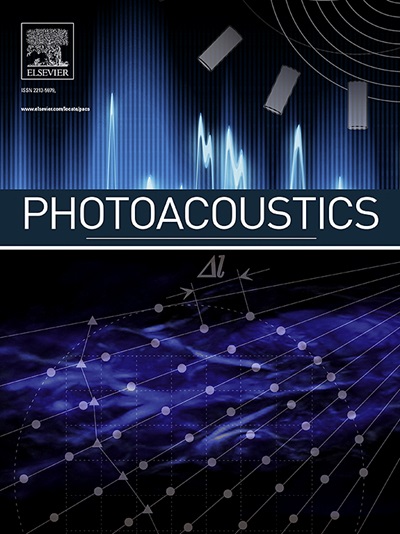All-optical in vivo photoacoustic tomography by adaptive multilayer acoustic backpropagation
IF 6.8
1区 医学
Q1 ENGINEERING, BIOMEDICAL
引用次数: 0
Abstract
Photoacoustic tomography (PAT) combines high optical contrast with deep acoustic penetration, making it valuable for biomedical imaging. However, all-optical systems often face challenges in measuring the acoustic wave-induced displacements on rough and dynamic tissues surfaces. We present an all-optical PAT system enabling fast and high-resolution volumetric imaging in vivo. By integrating holographic microscopy with a soft cover layer and coherent averaging, the system detects ultrasound-induced surface displacements over a 10 × 10 mm² area with 0.5 nm sensitivity in 1 s. A novel backpropagation algorithm reconstructs a depth-selective pressure image from two consecutive displacement maps. The coherent summation of these depth-selective pressure images enables the reconstruction of a 3D acoustic pressure image. Using adaptive multilayer backpropagation, we achieve imaging depths of up to 5 mm, with lateral and axial resolutions of 158 µm and 92 µm, respectively, demonstrated through in vivo imaging of mouse vasculature and chicken embryo vessels.
自适应多层声反向传播的全光体内光声层析成像
光声断层扫描(PAT)结合了高光学对比度和深声穿透,使其在生物医学成像中具有重要价值。然而,全光学系统在测量粗糙和动态组织表面声波引起的位移时经常面临挑战。我们提出了一种全光学PAT系统,可以实现体内快速和高分辨率的体积成像。通过将全息显微镜与软覆盖层和相干平均相结合,该系统可以在1 s内以0.5 nm的灵敏度检测到10 × 10 mm²区域内超声波引起的表面位移。一种新的反向传播算法从两个连续的位移图中重建深度选择的压力图像。这些深度选择压力图像的相干求和可以重建3D声压图像。利用自适应多层反向传播技术,通过小鼠血管和鸡胚血管的体内成像,我们实现了高达5 mm的成像深度,横向和轴向分辨率分别为158 µm和92 µm。
本文章由计算机程序翻译,如有差异,请以英文原文为准。
求助全文
约1分钟内获得全文
求助全文
来源期刊

Photoacoustics
Physics and Astronomy-Atomic and Molecular Physics, and Optics
CiteScore
11.40
自引率
16.50%
发文量
96
审稿时长
53 days
期刊介绍:
The open access Photoacoustics journal (PACS) aims to publish original research and review contributions in the field of photoacoustics-optoacoustics-thermoacoustics. This field utilizes acoustical and ultrasonic phenomena excited by electromagnetic radiation for the detection, visualization, and characterization of various materials and biological tissues, including living organisms.
Recent advancements in laser technologies, ultrasound detection approaches, inverse theory, and fast reconstruction algorithms have greatly supported the rapid progress in this field. The unique contrast provided by molecular absorption in photoacoustic-optoacoustic-thermoacoustic methods has allowed for addressing unmet biological and medical needs such as pre-clinical research, clinical imaging of vasculature, tissue and disease physiology, drug efficacy, surgery guidance, and therapy monitoring.
Applications of this field encompass a wide range of medical imaging and sensing applications, including cancer, vascular diseases, brain neurophysiology, ophthalmology, and diabetes. Moreover, photoacoustics-optoacoustics-thermoacoustics is a multidisciplinary field, with contributions from chemistry and nanotechnology, where novel materials such as biodegradable nanoparticles, organic dyes, targeted agents, theranostic probes, and genetically expressed markers are being actively developed.
These advanced materials have significantly improved the signal-to-noise ratio and tissue contrast in photoacoustic methods.
 求助内容:
求助内容: 应助结果提醒方式:
应助结果提醒方式:


